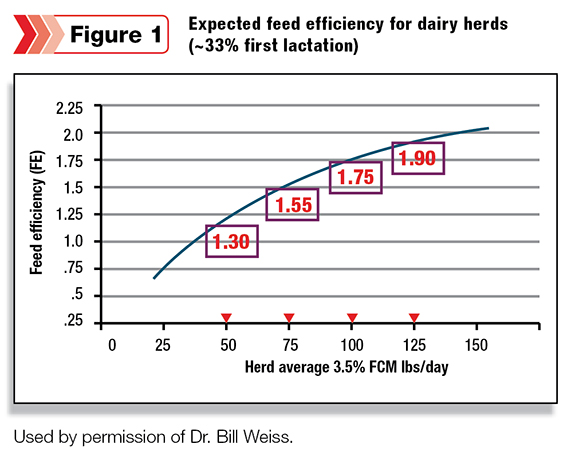The most profitable cow on your dairy is the fresh cow. She makes more milk more efficiently than at any other time of the lactation. Feeding fresh cows to maximize their peak milk production is some of the best money spent on your dairy.
With feed costs at an all-time high, grouping and feeding cows for maximum milk production and optimal feeding efficiency has become a central task for nutritionists and dairy farmers.
The challenge for many dairy farms is grouping fresh cows in practical ways that are both labor-efficient and cost-efficient.
Milk production drives a milk cow’s nutrient requirements. Immediately after freshening, cows produce many pounds of milk while their feed intakes are still lagging behind, which results in a negative energy balance for high-producing cows in early lactation.
The energy and protein densities in a pound of feed must be increased in an attempt to meet nutritional requirements and keep body condition loss to a minimum.
Cows experiencing a negative energy balance for extended periods of time will have less-productive lactations.
The monitoring of body condition in early lactation is a valuable tool with which to assess nutritional status in fresh cows. Loss of 1 to 1.5 points of body condition for fresh cows indicates that energy levels are seriously lacking in the diet.
One body condition score equals about 120 pounds for a Holstein cow. Fresh cows that drop to a body condition score (BCS) of less than 2 (on the five-point scale) will soon begin to decrease milk production so that energy and protein will be used to regain body condition. That milk production is permanently lost.
Dr. Bill Weiss, a dairy science professor at Ohio State University, stresses the importance of grouping fresh cows separately to meet their unique nutritional needs at the beginning of lactation.
He recommends that dairies should always have an “early” or “fresh” group of cows. The diet for this group should be formulated for 1.3X the actual milk yield.
In other words, if the average milk production in the early group is 80 pounds of milk per cow per day, the diet should be formulated to support 1.3X that amount, or 104 pounds of milk. Formulation must be based upon the group’s dry matter intakes (DMI).
According to Weiss, cows should be grouped according to their production potential and diets should be formulated according to correct specifications.
Dairy farmers who do not structure their herds to have a fresh group will be underfeeding their fresh cows, and they’ll be missing out on peak milk production.
Likewise, feeding the entire herd diets with high energy densities to support 100 pounds of milk is a recipe for disaster. Once cows are past their peaks, milk support can be reduced to about 1.15X the average group milk production.

In today’s economic environment, it’s tempting to reduce nutrient densities and try to feed less expensive diets – hoping milk production will not drop off too much.
Another valuable tool for keeping feed costs in line is to monitor how much milk is produced for every pound of feed dry matter consumed.
The goal for monitoring feeding efficiency in a dairy herd is to maximize milk production relative to feed consumption.
To compensate for various breeds and fat tests, feeding efficiency must be standardized to 3.5 percent milk fat. The formula to do that is as follows:
3.5 kg fat-corrected milk (FCM) = .4318*kg milk + 16.23 kg fat
Note that this formula calculates in kilograms. Pounds of milk must be converted to kilograms of milk by dividing pounds by 2.2. When the calculation is complete, convert kilograms back to pounds by multiplying kilograms by 2.2.
Once again, it’s imperative that you have accurate values for DMI in the group of cows being measured. Feed intakes should be measured and recorded several days in a row to get an accurate average in a group.
Feed efficiency is then calculated by FCM/DMI.
As an example, what this tells us is that a Jersey cow producing 40 pounds of milk with a 5.0 percent butterfat test, consuming about 30 pounds of feed dry matter, has a better feed efficiency at 1.6 than a Holstein cow producing 60 pounds of milk with a 3.9 percent butterfat test, consuming about 40 pounds of feed dry matter, resulting in a 1.5 feed efficiency.
For most herds, feed efficiency will vary between 1.3 to 2.0, and generally an average feed efficiency for the entire herd, with about one-third of the cows in first lactation, will be around 1.5.
Higher feed efficiency indicates your cows are doing an excellent job of making milk with the levels of feed they are consuming. Cows producing more than 100 pounds of FCM should have an feed efficiency of more than 1.75.
Cows with low FCM will, most of the time, also have a low feed efficiency since a greater proportion of their feed is being used for maintenance needs. Herds that are long in days-in-milk will also have low feed efficiency.
Herds with average feed efficiency of less than 1.3 are doing a poor job of converting feed to milk. Feed efficiencies below 1.0 indicate a serious problem with feeding cows and making milk.
There’s no avoiding the fact that in order to get cows to produce to their potential and reach and maintain high milk peaks, they must be fed accurately formulated diets with properly balanced nutrients.
Structuring herds and grouping cows so they can be fed optimally at the correct time of the lactation will not only improve milk production but will help keep feed costs from getting out of hand. PD

John Hibma
Nutritionist
Central Connecticut Co-operative Farms Association






